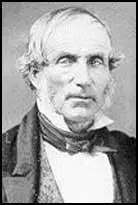William A. Richardson

William Richardson was born in London on 27th August, 1795. At the age of twelve he went to sea. In 1822, at the age of twenty seven, he sailed into Yerba Buena Cove, aboard a whaling ship, L'Orient.
There had been a dispute on board ship and he petitioned the Spanish governor for permission to remain in Alta California. He agreed as long as he promised to teach the local people at Mission San Francisco de Asís how to construct small boats for use in the bay. Richardson, who was fluent in Spanish, became the first non-Spanish European to settle in the area.
One of his first projects was the construction of a small boat which he used to move people and cargo around the bay. In 1823 Richardson converted to Catholicism, became a naturalized citizen of Mexico, and changed his name to Guillermo Antonio Richardson. Two years later he married Maria Antonia Martinez (1803–1887), the daughter of Ygnacio Martinez, commandant of the Presidio of Yerba Buena. Richardson now became involved in in the expanding California coastal trade.
Monterey was the main port of entry for Spanish ships. In 1835 Governor José Figueroa made Yerba Buena, an alternative port and invited Richardson to assume the position of Port Captain. He also started a profitable shipping company and ran the sole ferry company across the Bay. Richardson also laid out the street plan for the settlement of Yerba Buena.
Richardson purchased a plot in the expanding settlement and constructed a home for his family. In 1838 Richardson obtained a 20,000 acre grant of land across the bay from Yerba Buena. In 1841 he sold his property in Yerba Buena and moved his family to the 19,751 acre farm that became known as Rancho Saucelito. The local harbour became known as Richardson's Bay, and most of the ships entering Yerba Buena Cove, obtained their water and supplies there. Richardson took part in smuggling and he was eventually lost his job as Port Captain.
Richard Pakenham was a British diplomat serving in Mexico. In 1841 he wrote to Lord Palmerston, the foreign secretary, urging the British government "to establish an English population in the magnificent Territory of Upper California... no part of the World offering greater natural advantages for the establishment of an English colony... by all means desirable... that California, once ceasing to belong to Mexico, should not fall into the hands of any power but England... daring and adventurous speculators in the United States have already turned their thoughts in this direction."
Politicians in the United States became aware that Britain and France were both interested in taking Texas and California from Mexico. In 1842, Waddy Thompson, Jr., a former member of Congress, argued that the United States should consider taking control of California: "As to Texas I regard it as of very little value compared with California, the richest, the most beautiful and the healthiest country in the world... with the acquisition of Upper California we should have the same ascendancy on the Pacific... France and England both have had their eyes upon it." Later that year the American government asked John C. Fremont to lead an expedition to California in 1842. His reports on the fine weather, fertile land and mineral wealth in the region encouraged Americans to make the overland journey to California.
In July, 1845, the United States Army, under the leadership of Zachary Taylor, arrived in Texas. Talks began with the Mexican government but on 29th December, 1845, James Polk, the president of the United States, announced Texas had become the 28th state. This action was the start of the Mexican War. Taylor defeated the Mexicans at Palo Alto on 8th May, 1846 while General Winfield Scott organised a campaign that involved a sea borne invasion of Mexico that captured Vera Cruz and a march inland to Mexico City, which was captured on 14th September, 1846. Meanwhile General Stephen Kearny conquered New Mexico and with the support of John Fremont took control of California.
When Commodore Robert Stockton arrived in Yerba Buena aboard the USS Congress he used Richardson as his pilot and subsequently named him Port Captain. In 1847 Yerba Buena was renamed San Francisco.
Richardson initially did well from the discovery of gold by James Marshall while building sawmill at Coloma, on the South Fork of the American River, upstream from Sutter's Fort, about 115 miles northeast of San Francisco. In 1849 over 100,000 people had arrived in search of gold. During the next few years thousands more arrived. The output of gold rose from $5 million in 1848 to $40 million in 1849 and $55 million in 1851.
Richardson invested some of his profits in a plan designed by Joseph Yves Limantour and William Heath Davis to develop San Diego City. However, Richardson was a victim of land fraud and he lost most of his money in the venture. The situation was made worse when all three of his trading vessels were lost in shipwrecks during 1855.
William Richardson died on 20th April, 1856, after he took an overdose of mercury tablets.
